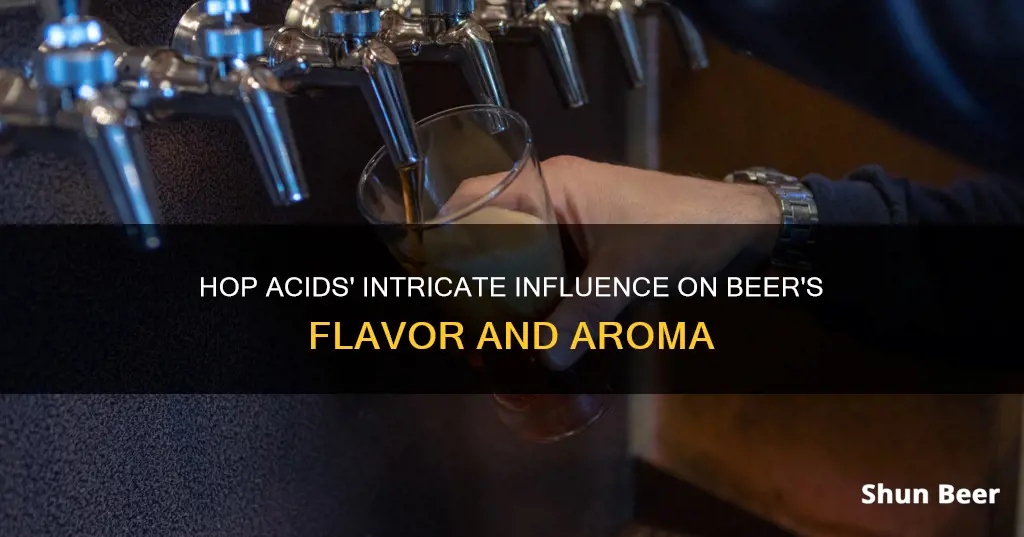
The bitter acids in hops, including α-, β-, and iso-α-acids, have a significant impact on the quality of beer and offer various physiological effects. Iso-α-acids (IAAs), the main bitter components of beer, have been found to enhance cognitive functions, including memory. On the other hand, Matured Hop Bitter Acids (MHBAs), which are oxidation products derived from aged hops, have been linked to reduced body fat in healthy adults and the induction of thermogenesis in brown adipose tissue. While the effects of hop acids on beer characteristics and human health are intriguing, further research is needed to fully understand the oxidation process and its consequences.
What You'll Learn

Hop acids are responsible for the bitterness of beer
Hop acids, specifically iso-α-acids (IAAs), are the main contributors to the bitterness of beer. These bitter acids are derived from hops (Humulus lupulus L.), and their presence in beer significantly impacts its overall quality and flavour profile.
IAAs are responsible for the characteristic bitter taste of beer, and their concentration plays a crucial role in determining the intensity of bitterness perceived by drinkers. The higher the concentration of IAAs, the more pronounced the bitterness will be.
In addition to their role in flavour, hop acids also exhibit various physiological effects. Studies have suggested that IAAs can enhance cognitive functions, particularly hippocampus-dependent memory and prefrontal cortex-associated cognitive processes. This enhancement is believed to occur through the activation of dopamine neurotransmission.
Furthermore, matured hop bitter acids (MHBAs), which are oxidation products of the bitter components in hops, have been found to induce thermogenesis in brown adipose tissue (BAT) via sympathetic nerves. This process has been shown to reduce body fat in healthy adults, indicating a potential health benefit associated with the consumption of hop-bitter acids.
While the bitterness of beer is a desirable quality for many beer enthusiasts, it is important to note that the oxidation of hop acids can impact the properties of the beer. However, the specific effects of oxidation on beer characteristics and potential health benefits are not yet fully understood and require further research.
Hemp and Hops: Exploring the Botanical Cousins
You may want to see also

Hop acids have antibacterial properties, which help to prevent bacterial proliferation
Hops have been used for centuries for their medicinal properties, including their antibacterial qualities. The bitter acids in hops, such as α-acids (humulones) and β-acids (lupulones), are known to prevent the growth of bacteria. This antibacterial property is especially effective against Gram-positive bacteria and certain viruses, such as hepatitis C and HIV. For example, applying β-acids to pork tenderloins significantly reduced the total aerobic bacteria count.
Hop acids, specifically β-acids, are also used in the sugar industry to prevent the development of anaerobic bacteria that spoil products. In addition, the antimicrobial properties of hop extracts have been shown to be effective against acne-causing bacteria, such as Propionibacterium acnes and Staphylococcus aureus. The antibacterial activity of hop extracts is also beneficial in meat applications, where they can act as natural preservatives to extend the shelf life and enhance the safety of fresh meat products.
The antibacterial properties of hop acids are not limited to external applications; they also play a crucial role in the brewing process of beer. Beer is susceptible to bacterial contamination, which can lead to off-flavours and quality issues. By incorporating hop acids into the brewing process, brewers can harness their antibacterial properties to prevent the proliferation of undesirable bacteria. This helps ensure the safety and quality of the final beer product, contributing to a longer shelf life and a more stable beverage.
While the exact mechanism by which hop acids exert their antibacterial effects is not fully understood, their ability to inhibit bacterial growth is well-documented. The antibacterial activity of hop acids is attributed to their ability to disrupt bacterial cell walls and interfere with cellular processes, ultimately preventing the proliferation of harmful bacteria. This makes hop acids a valuable tool in various industries, from brewing to food preservation and even in medical applications, where they may play a role in combating bacterial infections.
Belgian Beer and Hops: A Complex Relationship
You may want to see also

Hop acids can improve cognitive functions
Hop acids, specifically iso-α-acids (IAAs) and matured hop bitter acids (MHBAs), have been found to improve cognitive functions. IAAs are the main bitter components of beer, and they enhance hippocampus-dependent memory and prefrontal cortex-associated cognitive function via dopamine neurotransmission activation. This activation of the dopaminergic system is associated with improved spatial and episodic memory functions.
The effects of IAAs on cognitive enhancement are further supported by rodent studies. These studies demonstrate that IAAs improve memory and higher-order cognitive functions such as attention and executive function. Furthermore, supplementation with IAAs has been shown to attenuate neuroinflammation and cognitive impairments in rodent models of neurodegeneration, including Alzheimer's disease.
MHBAs, on the other hand, are oxidized compounds derived from aged hops. They enhance memory functions through norepinephrine neurotransmission-mediated mechanisms. Similar to IAAs, MHBAs also stimulate the vagus nerve, leading to improved cognitive function.
The cognitive benefits of hop acids are not limited to animal studies. Research suggests that supplementation with MHBAs improves cognitive performance, attention, and mood state in healthy older adults. This finding highlights the potential of hop acids as a safe and effective strategy to enhance cognitive function, particularly in populations at risk of cognitive decline.
Overall, the available evidence suggests that hop acids, through their ability to stimulate the vagus nerve and modulate neurotransmission, have a positive impact on cognitive functions. Further research is needed to fully understand the complex mechanisms underlying these effects and to optimize their potential as a therapeutic intervention for cognitive health.
The Historical Addition of Hops to Beer
You may want to see also

Hop acids can be used to stabilize beer foam
Hop acids, such as α-, β-, and iso-α-acids, are crucial components of beer, derived from hops (Humulus lupulus L.). These hop acids significantly impact beer quality and offer a range of physiological effects. One of their essential roles is in stabilizing beer foam, which is fundamental to the beer's overall character and sensory experience.
Beer foam, created primarily from carbon dioxide rising through the beer and proteins provided by the malt, is inherently unstable. This instability arises from the foam's protein matrix, which can break down due to various factors, including excess carbonation, improper pouring, or the presence of fatty compounds. However, hop acids play a critical role in counteracting this instability and promoting a stable, long-lasting foam head.
The key mechanism by which hop acids stabilize beer foam involves their interaction with the proteins in the beer matrix. Iso-α-acids (IAAs), the main bitter components of beer, possess unique surfactant-like properties. When incorporated into the beer matrix, IAAs act at the air-liquid interface, stabilizing the foam by slowing the rate of bubble coalescence and collapse. This stabilizing effect is attributed to the hydrophobicity of IAAs, which allows them to associate with the proteins, enhancing their functionality and reinforcing the foam structure.
Additionally, hop acids contribute to foam stability by influencing the overall surface tension of the beer. The presence of hop acids reduces the surface tension, making it easier for carbon dioxide bubbles to rise to the surface and form a foam head. This reduction in surface tension is believed to be caused by the adsorption of hop acid molecules onto the air-liquid interface, creating a more stable and resilient foam.
To optimize foam stability, brewers can strategically adjust the levels of hop acids in the brewing process. By carefully controlling the type and amount of hops added during brewing, brewers can fine-tune the beer's foam characteristics, ensuring a consistent and appealing presentation. This manipulation of hop acids allows brewers to create beers with varying foam stability, catering to different styles and consumer preferences. In summary, hop acids are essential tools for brewers to manage beer foam stability, contributing to the overall sensory experience and quality of the final product.
Dry Hop Beer: Aging and Its Effects
You may want to see also

Hop acids can be used to prevent lightstruck flavour in beer
Hop acids, such as α-, β-, and iso-α-acids, are the main bitter components of beer, affecting both its quality and flavour. Iso-α-acids (IAAs), in particular, are responsible for the bitter taste of beer. While these compounds readily oxidize, their oxides have been shown to offer potential health benefits.
Matured hop bitter acids (MHBAs) are oxidized compounds derived from aged hops. They are known to enhance hippocampus-dependent memory and prefrontal cortex-associated cognitive function via dopamine neurotransmission activation. Additionally, MHBAs have been found to reduce body fat in healthy adults by inducing thermogenesis in brown adipose tissue via sympathetic nerves.
The presence of hop acids in beer can also help prevent lightstruck flavour, a phenomenon where beer develops an unpleasant sulphur-like taste due to the reaction of certain compounds when exposed to light. Hop acids act as a protective barrier, absorbing light and preventing the breakdown of these compounds, thus preserving the desired flavour of the beer.
Furthermore, the use of hop acids can contribute to the overall stability of beer. They possess antimicrobial properties, particularly effective against negative beer-spoiling bacteria, which can cause off-flavours and haze formation. By inhibiting the growth of these microorganisms, hop acids help extend the shelf life of beer and maintain its sensory qualities.
In conclusion, hop acids play a crucial role in the brewing process and the final beer product. Beyond adding bitterness and flavour, their ability to prevent lightstruck flavour and their potential health benefits contribute to the overall appeal and enjoyment of beer.
Hops in Beer: Friend or Foe for Sore Throats?
You may want to see also
Frequently asked questions
Hop acids are bitter components in hops, which are used to add flavour and bitterness to beer.
The main types of hop acids include α-acids, β-acids, and iso-α-acids.
Hop acids have been shown to induce thermogenesis in brown adipose tissue (BAT) via sympathetic nerves, reducing body fat in healthy adults. They also influence cognitive functions, enhancing memory and prefrontal cortex-associated cognitive processes.
MHBA refers to oxidized products derived from the bitter components in hops. They are known to affect beer quality and exhibit various physiological effects, although the full extent of their impact on beer properties and human health is not yet fully understood.
In addition to their potential weight management properties, hop acids may offer cognitive benefits by enhancing memory and cognitive functions. Research also suggests potential neuroprotective effects, with hop-derived bitter acids showing promise in reducing neuroinflammation and cognitive impairments associated with neurodegeneration.







